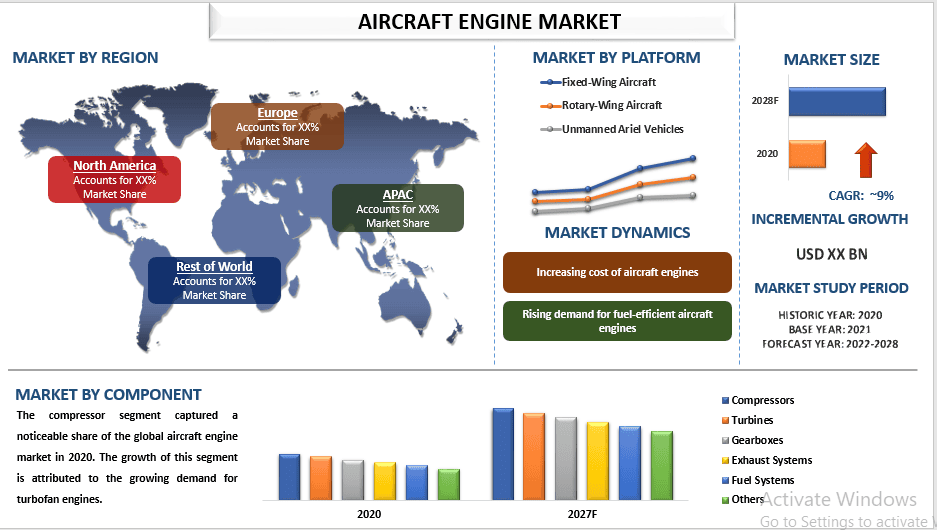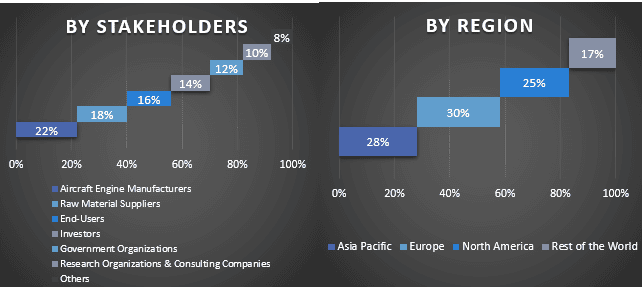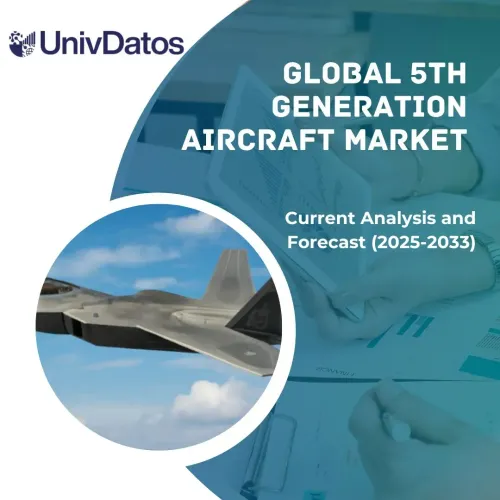- Startseite
- Über uns
- Industrie
- Dienstleistungen
- Lesen
- Kontaktieren Sie uns
Flugzeugtriebwerksmarkt: Aktuelle Analyse und Prognose (2022-2028)
Schwerpunkt auf Typ (Turboprop, Turbofan, Turbowelle und Kolbenmotor); Komponente (Verdichter, Turbinen, Getriebe, Abgassysteme, Kraftstoffsysteme und Sonstige); Plattform (Flugzeuge, Drehflügler und unbemannte Luftfahrzeuge); Technologie (Konventionell und Hybrid); und Region/Land

KOSTENLOSE MUSTER-PDF ANFORDERN
Es wird erwartet, dass der globale Markt für Flugzeugtriebwerke im Prognosezeitraum 2022-2028 mit einer Wachstumsrate von rund 9 % wachsen wird. Ein Flugzeugtriebwerk ist eine Komponente des Antriebssystems eines Flugzeugs, das mechanische Leistung erzeugt. Flugzeugtriebwerke sind meistens entweder leichte Kolbenmotoren oder Gasturbinen. Die zunehmenden kommerziellen Flugzeugbetriebe und der Anstieg der militärischen Flugzeugbetriebe sind einige der wichtigsten Faktoren, die sich auf den Markt für Flugzeugtriebwerke auswirken. Darüber hinaus fördern Faktoren wie die steigende Nachfrage nach treibstoffeffizienten Flugzeugtriebwerken, die steigende Nachfrage nach unbemannten Luftfahrzeugen (UAVs) für kommerzielle und militärische Anwendungen und die wachsende Zusammenarbeit bei der Entwicklung fortschrittlicher Flugzeugtriebwerke das Wachstum des Marktes für Flugzeugtriebwerke. Beispielsweise hat GE Aerospace einen Vertrag mit Tata Advanced über Flugzeugtriebwerkskomponenten verlängert. Der mehrjährige langfristige Vertrag hat einen Wert von über 1 Mrd. USD und läuft bis weit über das Jahr 2030 hinaus.
Zu den wichtigsten Akteuren auf dem Markt gehören General Electric, Rolls-Royce plc, Raytheon Technologies Corporation, Safran, Honeywell International Inc., Textron Inc., International Aero Engines AG, The Williams Companies Inc., MTU Aero Engines AG, Eurojet sind einige der wichtigsten Akteure auf dem Markt. Mehrere M&As sowie Partnerschaften wurden von diesen Akteuren eingegangen, um Kunden mit Hightech- und innovativen Produkten/Technologien zu unterstützen.
Im Bericht dargestellte Einblicke
„Unter den Typen wird das Segment der Turbofan-Triebwerke im Prognosezeitraum einen robusten CAGR erleben“
Basierend auf dem Typ wird der Markt in Turboprop-, Turbofan-, Turboshaft- und Kolbentriebwerke unterteilt. Unter diesen wird erwartet, dass das Turbofan-Triebwerk im Prognosezeitraum mit einer hohen CAGR wachsen wird. Dies liegt daran, dass die meisten modernen Verkehrsflugzeuge Turbofan-Triebwerke wegen ihres hohen Schubs und ihrer guten Treibstoffeffizienz verwenden. Dieser Triebwerkstyp wird häufig in Großraumflugzeugen wie der Boeing 747 und dem Airbus A300 eingesetzt.
„Unter den Technologien hatte das Segment Starrflügler im Jahr 2020 einen bedeutenden Marktanteil“
Basierend auf der Plattform wird der Markt in Starrflüglerflugzeuge, Drehflüglerflugzeuge und unbemannte Luftfahrzeuge unterteilt. Das Starrflüglersegment hatte im Jahr 2020 einen bedeutenden Anteil am globalen Markt für Flugzeugtriebwerke. Flexibilität, Datensicherheit, hohe Geschwindigkeit und geringe Latenz sind die wichtigsten Faktoren, die das Wachstum dieses Segments vorantreiben. Die On-Premises-Bereitstellung ermöglicht Unternehmen die physische Kontrolle über die Daten und beschränkt den Zugriff auf kritische Daten auf die Unternehmen.
Sprechen Sie mit einem Analysten
„Der asiatisch-pazifische Raum hatte im Jahr 2020 einen bemerkenswerten Marktanteil“
Es wird erwartet, dass der asiatisch-pazifische Raum im Prognosezeitraum einen bedeutenden Anteil am globalen Markt für Flugzeugtriebwerke halten wird, hauptsächlich aufgrund des steigenden Verteidigungsbudgets der großen Volkswirtschaften in der Region. Dies hat die Nachfrage nach der Beschaffung von Militärhubschraubern und Kampfjets geschaffen, was das Wachstum des Marktes voraussichtlich ankurbeln wird. Beispielsweise gab die indische Regierung im Jahr 2021 76,6 Mrd. USD für ihr Militär aus, wovon 39 % der indischen Luftwaffe zugewiesen wurden, die hauptsächlich für den Bau militärischer Flugzeuge im Inland verwendet wurde.
Gründe für den Kauf dieses Berichts:
- Die Studie umfasst eine Marktdimensionierungs- und Prognoseanalyse, die von authentifizierten wichtigen Branchenexperten validiert wurde.
- Der Bericht bietet einen schnellen Überblick über die Gesamtleistung der Branche auf einen Blick.
- Der Bericht umfasst eine eingehende Analyse der wichtigsten Branchenkollegen mit einem primären Fokus auf wichtige Finanzdaten, Produktportfolios, Expansionsstrategien und aktuelle Entwicklungen.
- Detaillierte Untersuchung von Treibern, Hemmnissen, wichtigen Trends und Chancen, die in der Branche vorherrschen.
- Die Studie deckt den Markt umfassend über verschiedene Segmente hinweg ab.
- Tiefgreifende regionale Analyse der Branche.
Anpassungsoptionen:
Der globale Markt für Flugzeugtriebwerke kann je nach Anforderung oder einem anderen Marktsegment weiter angepasst werden. Darüber hinaus versteht UMI, dass Sie möglicherweise Ihre eigenen geschäftlichen Anforderungen haben. Zögern Sie daher nicht, sich mit uns in Verbindung zu setzen, um einen Bericht zu erhalten, der Ihren Anforderungen vollständig entspricht.
Inhaltsverzeichnis
Forschungsmethodik für die Marktanalyse von Flugzeugtriebwerken (2022-2028)
Die Analyse des historischen Marktes, die Schätzung des aktuellen Marktes und die Prognose des zukünftigen Marktes des globalen Marktes für Flugzeugtriebwerke waren die drei wichtigsten Schritte, die unternommen wurden, um die Akzeptanz von Flugzeugtriebwerken in wichtigen Regionen weltweit zu erstellen und zu analysieren. Es wurden umfassende Sekundärrecherchen durchgeführt, um die historischen Marktzahlen zu sammeln und die aktuelle Marktgröße zu schätzen. Zweitens wurden zahlreiche Erkenntnisse und Annahmen berücksichtigt, um diese Erkenntnisse zu validieren. Darüber hinaus wurden ausführliche Primärinterviews mit Branchenexperten entlang der Wertschöpfungskette des globalen Marktes für Flugzeugtriebwerke geführt. Nach der Annahme und Validierung der Marktzahlen durch Primärinterviews wendeten wir einen Top-Down-/Bottom-Up-Ansatz an, um die vollständige Marktgröße zu prognostizieren. Danach wurden Marktaufschlüsselungs- und Datentriangulationsmethoden angewandt, um die Marktgröße von Segmenten und Untersegmenten der jeweiligen Branche zu schätzen und zu analysieren. Die detaillierte Methodik wird im Folgenden erläutert:
KOSTENLOSES MUSTER ALS PDF ANFORDERN
Analyse der historischen Marktgröße
Schritt 1: Eingehende Untersuchung von Sekundärquellen:
Es wurde eine detaillierte Sekundärstudie durchgeführt, um die historische Marktgröße des Marktes für Flugzeugtriebwerke aus unternehmensinternen Quellen wie Geschäftsberichten & Finanzberichten, Performance-Präsentationen, Pressemitteilungen usw. und externen Quellen wie Fachzeitschriften, Nachrichten & Artikeln, Regierungsveröffentlichungen, Wettbewerberveröffentlichungen, Sektorberichten, Drittanbieterdatenbanken und anderen glaubwürdigen Veröffentlichungen zu erhalten.
Schritt 2: Marktsegmentierung:
Nachdem wir die historische Marktgröße des Marktes für Flugzeugtriebwerke ermittelt hatten, führten wir eine detaillierte Sekundäranalyse durch, um historische Markteinblicke und Anteile für verschiedene Segmente und Untersegmente für wichtige Regionen zu sammeln. Die wichtigsten im Bericht enthaltenen Segmente sind Typ, Komponente, Plattform und Technologie. Darüber hinaus wurden länderbezogene Analysen durchgeführt, um die allgemeine Akzeptanz von Testmodellen in der jeweiligen Region zu bewerten.
Schritt 3: Faktorenanalyse:
Nachdem wir die historische Marktgröße verschiedener Segmente und Untersegmente ermittelt hatten, führten wir eine detaillierte Faktorenanalyse durch, um die aktuelle Marktgröße des Marktes für Flugzeugtriebwerke zu schätzen. Darüber hinaus führten wir eine Faktorenanalyse unter Verwendung abhängiger und unabhängiger Variablen wie Typ, Komponente, Plattform und Technologie von Flugzeugtriebwerken durch. Es wurde eine gründliche Analyse für Nachfrage- und Angebotsseitenszenarien unter Berücksichtigung von Top-Partnerschaften, Fusionen und Übernahmen, Geschäftsausweitungen und Produkteinführungen im Sektor für Flugzeugtriebwerke auf der ganzen Welt durchgeführt.
Aktuelle Marktschätzung & Prognose
Aktuelle Marktgröße: Basierend auf den umsetzbaren Erkenntnissen aus den oben genannten 3 Schritten ermittelten wir die aktuelle Marktgröße, die wichtigsten Akteure auf dem globalen Markt für Flugzeugtriebwerke und die Marktanteile der Segmente. Alle erforderlichen prozentualen Anteile und Marktaufschlüsselungen wurden anhand des oben genannten sekundären Ansatzes ermittelt und durch Primärinterviews verifiziert.
Schätzung & Prognose: Für die Marktschätzung und -prognose wurden verschiedenen Faktoren, einschließlich Treiber & Trends, Einschränkungen und Chancen, die den Beteiligten zur Verfügung stehen, Gewichtungen zugewiesen. Nach der Analyse dieser Faktoren wurden relevante Prognosetechniken, d. h. der Top-Down-/Bottom-Up-Ansatz, angewendet, um die Marktprognose für 2027 für verschiedene Segmente und Untersegmente in den wichtigsten Märkten weltweit zu erstellen. Die Forschungsmethodik, die zur Schätzung der Marktgröße angewendet wird, umfasst:
- Die Marktgröße der Branche in Bezug auf den Umsatz (USD) und die Akzeptanzrate des Marktes für Flugzeugtriebwerke in den wichtigsten Märkten im Inland
- Alle prozentualen Anteile, Aufteilungen und Aufschlüsselungen von Marktsegmenten und Untersegmenten
- Wichtige Akteure auf dem globalen Markt für Flugzeugtriebwerke in Bezug auf die angebotenen Produkte. Außerdem die von diesen Akteuren angewandten Wachstumsstrategien, um im schnell wachsenden Markt wettbewerbsfähig zu sein
Validierung von Marktgröße und -anteil
Primärforschung: Es wurden eingehende Interviews mit den wichtigsten Meinungsbildnern (Key Opinion Leaders, KOLs) geführt, darunter Top Level Executives (CXO/VPs, Vertriebsleiter, Marketingleiter, Betriebsleiter, Regionalleiter, Länderleiter usw.) in wichtigen Regionen. Die Ergebnisse der Primärforschung wurden dann zusammengefasst und eine statistische Analyse durchgeführt, um die aufgestellte Hypothese zu beweisen. Die Erkenntnisse aus der Primärforschung wurden mit den sekundären Erkenntnissen zusammengeführt, wodurch Informationen in umsetzbare Erkenntnisse umgewandelt wurden.
Aufteilung der primären Teilnehmer in verschiedenen Regionen

Markt Engineering
Die Datentriangulationstechnik wurde angewendet, um die Gesamtmarktschätzung abzuschließen und präzise statistische Zahlen für jedes Segment und Untersegment des globalen Marktes für Flugzeugtriebwerke zu erhalten. Die Daten wurden in mehrere Segmente & Untersegmente aufgeteilt, nachdem verschiedene Parameter und Trends in den Bereichen Typ, Komponente, Plattform und Technologie auf dem globalen Markt für Flugzeugtriebwerke untersucht wurden.
Das Hauptziel der Global Aircraft Engine Market Study
Die aktuellen und zukünftigen Markttrends des globalen Marktes für Flugzeugtriebwerke wurden in der Studie aufgezeigt. Investoren können strategische Einblicke gewinnen, um ihre Entscheidungen für Investitionen auf der Grundlage der in der Studie durchgeführten qualitativen und quantitativen Analyse zu treffen. Aktuelle und zukünftige Markttrends bestimmten die Gesamtattraktivität des Marktes auf regionaler Ebene und boten den Branchenteilnehmern eine Plattform, um den unerschlossenen Markt zu nutzen und von einem First-Mover-Vorteil zu profitieren. Weitere quantitative Ziele der Studien sind:
- Analyse der aktuellen und prognostizierten Marktgröße des Marktes für Flugzeugtriebwerke in Bezug auf den Wert (USD). Analysieren Sie auch die aktuelle und prognostizierte Marktgröße verschiedener Segmente und Untersegmente
- Die Segmente in der Studie umfassen die Bereiche Typ, Komponente, Plattform und Technologie
- Definition und Analyse des regulatorischen Rahmens für die Flugzeugtriebwerksindustrie
- Analyse der Wertschöpfungskette mit der Präsenz verschiedener Intermediäre sowie Analyse des Kunden- und Wettbewerberverhaltens der Branche
- Analyse der aktuellen und prognostizierten Marktgröße des Marktes für Flugzeugtriebwerke für die wichtigsten Regionen
- Zu den wichtigsten Ländern der in dem Bericht untersuchten Regionen gehören der asiatisch-pazifische Raum, Europa, Nordamerika und der Rest der Welt
- Unternehmensprofile des Marktes für Flugzeugtriebwerke und die von den Marktakteuren angewandten Wachstumsstrategien, um im schnell wachsenden Markt zu bestehen
Eingehende Analyse der Branche auf regionaler Ebene
Verwandt Berichte
Kunden, die diesen Artikel gekauft haben, kauften auch










